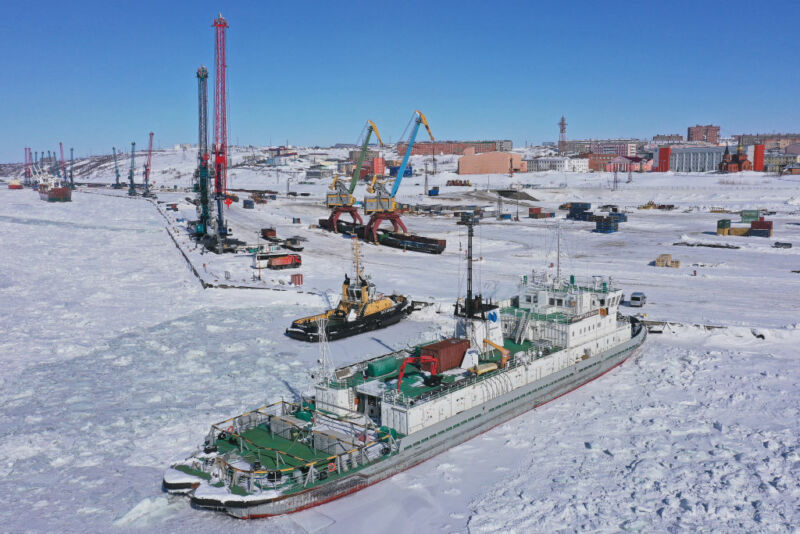
Traveling by boat through Canada's Arctic waters is no easy feat. Beyond the ice and the cold, the region is one of the most complex geographies on Earth, containing some 36,000 islands of varying size. But the nature of the Arctic is shifting thanks to climate change, and according to new research, the nautical pathways through the region are likely to become easier to traverse as the world warms and its ice becomes less common.
The new paper projects how navigable the Canadian Arctic will be in a progressively warmer world. The research began in 2017 and was performed in an effort to model climate change in a way that was digestible and useful for policymakers and people living in Arctic communities. "We need to think about indicators at a local scale, or a decision-making scale," said Jackie Dawson, one of the paper's authors and a professor in the University of Ottawa's department of geography, environment, and geomatics.
While the paper also looks into the policy and social implications of different warming scenarios, we would be better off if we kept the climate from warming. The likelihood of reaching some of the paper's more dire scenarios "[depends] on what actions we take in the future, is what it boils down to," Lawrence Mudryk—a research scientist with Environment and Climate Change Canada and one of the paper's authors—told Ars.
Setting a course for 4º C
To figure out how Canada's area of the Arctic would respond to increasing temperatures, the team ran a climate model several times, each time with a slightly different set of factors. Through this process, the team saw the expected conditions of Arctic ice when the world reaches 1º C (where we currently are, more or less), 2º C, or 4º C above pre-Industrial Revolution levels. The researchers also looked into the amount of time each year in which the Arctic would be open for shipping for different classifications of vessels, such as icebreakers and passenger ships.
The paper also breaks these findings down by region within the Arctic along major trade routes like the Northwest Passage, for instance. The extent to which the warming impacts each region varies. As temperatures rise, the sea ice will thin and recede, and more of the region will be navigable via ship throughout more of a given year.
So, for example, in the case of 2º C of warming, there is a 100 percent probability of each type of vessel identified in the study being able to navigate the Northwest Passage and Arctic Bridge trade routes for at least part of a year. Moreover, some places will be navigable for longer. The Beaufort Sea region, for instance, could see a dramatic lengthening in terms of its shipping seasons: 100 to 200 days at 2º C, and 200 to 300 days at 4º C.
Pros and (mostly) cons
The paper also discusses how these scenarios could impact Arctic communities, since using these insights and the paper's scenarios can help policymakers plan accordingly. In environmental terms, hitting, say, 4º C is bad news, but there are benefits—it's easier to move products via ship through the Arctic, for instance. Further, if the Arctic opens up, it would be easier to resupply the maritime Inuit communities up North by boat.
Dawson noted that, just because there is more shipping throughout the Arctic, that doesn't necessarily mean that Inuit and northern communities will necessarily reap any of the benefits from this potential increase in traffic. "Communities are going to be affected very differently depending on where they are. There will be both opportunities and risks," Dawson said. "We tried to focus on the question: 'What does this mean for the future of resupply to communities?'"
However, they could see a tourism boost from people with passenger boats. Further, if there's less ice in the Arctic, it's possible that the area that keeps a healthy amount of ice will be turned into a reserve for various Arctic species, which could also be a draw—a kind of "last-change tourism" opportunity, Mudryk said.
More ships, more problems
Communities in the region could also face more environmental issues as a product of the increased shipping—on top of the negatives associated with changes to the climate. Subsistence hunting is a major source of food in the region, since shipping food there is so difficult. The decrease in ice and increase in ships could push animals farther away from the communities, harming food security.
The ice is expected to grow thinner as the climate warms, which is something of a safety concern for people walking or hunting on it, Dawson noted. Boats could also bring invasive species with them—either through ballast exchange or hull fouling. Previously, the cold kept many invasive species away, but if the Arctic gets warm enough, they may be able to thrive.
According to John Walsh—a professor at the University of Alaska, Fairbanks, who has worked with the Arctic Council's Arctic Monitoring and Assessment Programme—even if the ice does let up, there will still be risks for ships in the area. "It's not going to be like the Suez Canal," he told Ars. Boats are still likely to crash, get grounded, or otherwise spill their contents in the region. And, in areas as remote as Canada's Arctic, cleaning up after an accident is particularly difficult.
"In a remote region like that, how you handle an accident or a spill is a real challenge," he said.
Nature Climate Change, 2021. DOI: 10.1038/s41558-021-01087-6
"much" - Google News
July 11, 2021 at 08:30PM
https://ift.tt/3hx1cdd
How much shipping can we get through a warming Arctic? - Ars Technica
"much" - Google News
https://ift.tt/37eLLij
Shoes Man Tutorial
Pos News Update
Meme Update
Korean Entertainment News
Japan News Update
Bagikan Berita Ini














0 Response to "How much shipping can we get through a warming Arctic? - Ars Technica"
Post a Comment